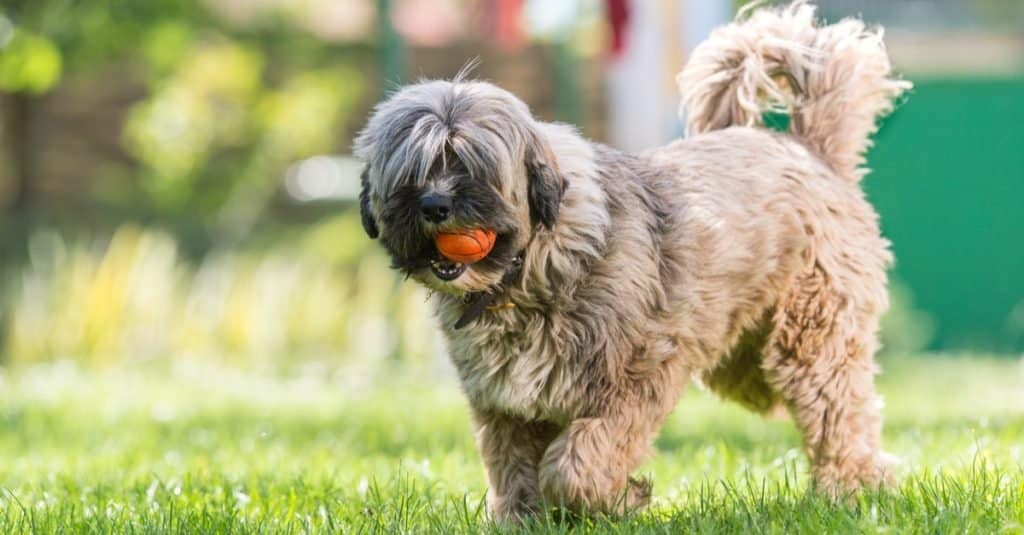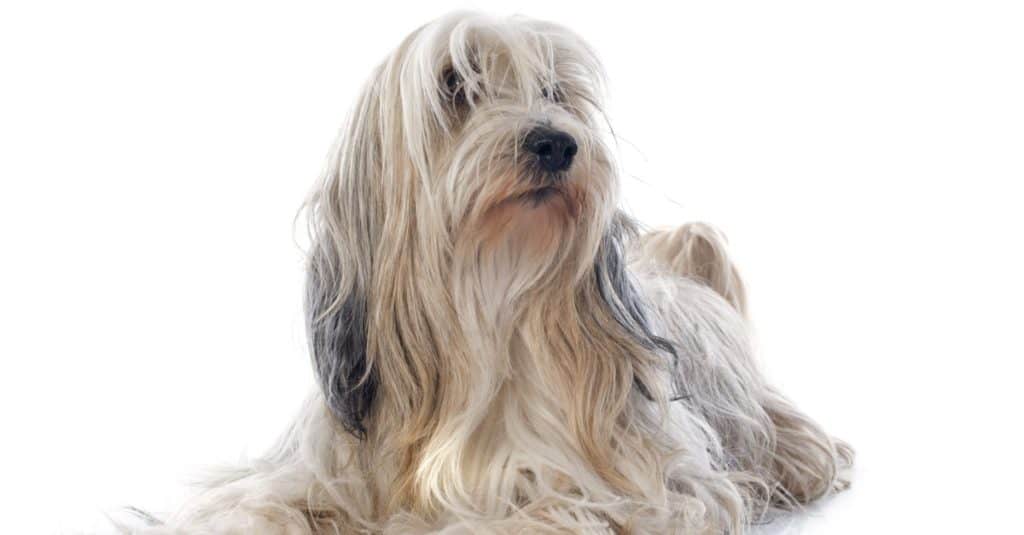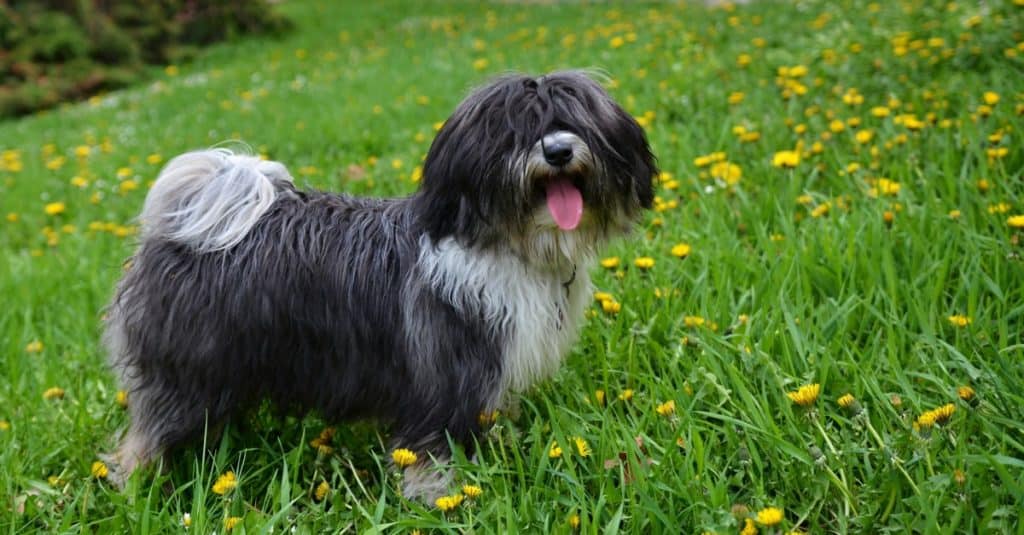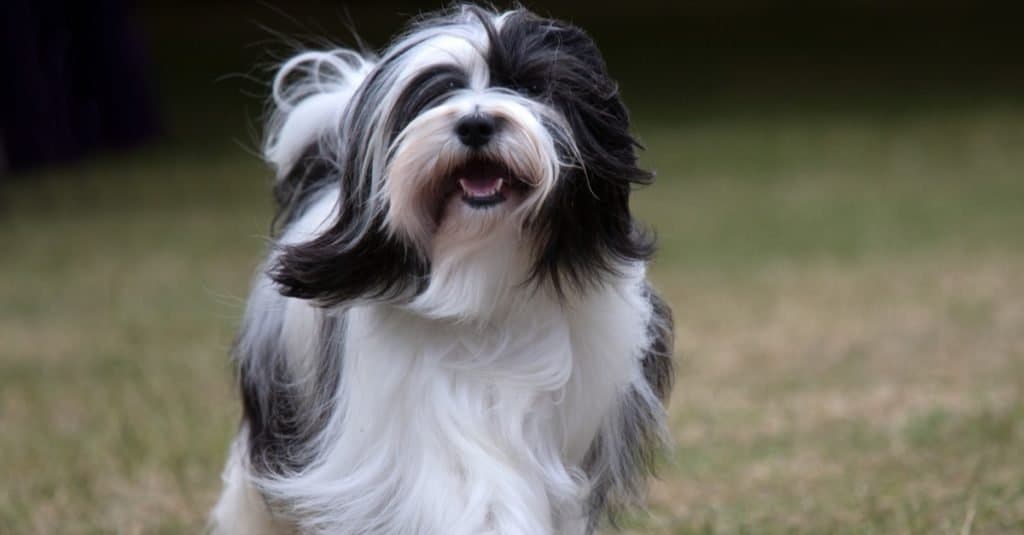Tibetan Terrier
Canis lupus
Tibetan terriers have round, flat, “snow shoe” feet that evolved to give them traction on snowy Himalayan paths
Advertisement
Tibetan Terrier Scientific Classification
- Kingdom
- Animalia
- Phylum
- Chordata
- Class
- Mammalia
- Order
- Carnivora
- Family
- Canidae
- Genus
- Canis
- Scientific Name
- Canis lupus
Read our Complete Guide to Classification of Animals.
Tibetan Terrier Conservation Status
Tibetan Terrier Facts
- Fun Fact
- Tibetan terriers have round, flat, “snow shoe” feet that evolved to give them traction on snowy Himalayan paths
- Temperament
- Energetic, playful and stubborn quiet and lazy
- Diet
- Omnivore
Tibetan Terrier as a Pet:
- General Health
- Energy Level
- Shedability
- Trainability
- Intelligence
- Tendency to Chew
- Size
- Family and kid friendliness
- Yappiness / Barking
- High
- Hypoallergenic
- Yes
- Separation Anxiety
- Moderate
- Preferred Temperature
- Cold climate
- Exercise Needs
- Moderate
- Friendly With Other Dogs
- Moderate
- Pure bred cost to own
- $1,000 - $2,000
- Dog group
- Terrier
- Male weight
- 26-30 lbs
- Female weight
- 22-26 lbs
This post may contain affiliate links to our partners like Chewy, Amazon, and others. Purchasing through these helps us further the A-Z Animals mission to educate about the world's species.
View all of the Tibetan Terrier images!
Tibetan terriers have round, flat, “snow shoe” feet that evolved to give them traction on snowy Himalayan paths.
A Tibetan terrier could easily be mistaken for a larger version of its cousin, the Lhasa apso. Like Lhasa apsos, Tibetan terriers have a long, historic association with Buddhist monasteries, and they also have that long front fringe, which frequently obscures their eyes. Despite their name, though, Tibetan terriers are not true terriers; they were not bred to hunt vermin but to guard the monasteries and help nomadic herdsmen tend their flocks. The lamas nicknamed this breed, “the Holy Dog.”
See all of our expert product reviews.
Tibetan terriers are medium-sized dogs with a squarish build, though it can be difficult to glimpse their bodies beneath their wooly double coats. They are friendly, energetic dogs who require a fair amount of exercise. Their highly independent natures make it critically important to establish who’s the boss when you first enter into a relationship with a Tibetan terrier. Hint: That boss should be you!

3 Pros And Cons Of Owning A Tibetan Terrier
| Pros! | Cons! |
|---|---|
| They’re adorable: With their shaggy hair, distinguished beards, long eyelashes, and quizzical expressions, it’s hard to find a dog that’s cuter than a Tibetan terrier. | They require a lot of grooming: You’ll need to brush your Tibetan terrier at least once a day to avoid mats and tangles. This breed also benefits from a bath every 10 days or so. If you decide to leave your pet’s coat long, it will become a magnet for leaves, twigs, mud, and other debris that will be tracked around your house, so many Tibetan terrier owners opt for keeping their pets’ coats short. |
| They’re very intelligent: Tibetan terriers learn tricks quickly and can be easily trained to participate in canine sports such as agility, obedience, tracking, and flyball. Their active minds make them mischievous when they think no one is looking, so it’s important to start training them from the time they’re puppies on how to be good when they’re alone in your house. | They shed: Tibetan terriers are often billed as hypoallergenic dogs that do not shed, but strictly speaking, this is not true. They lose their hair at about the same rate that humans slough their hair, but their coats are so long that the shed hair gets caught in their coats rather than on your sofa. They shed most vigorously when the seasons change. |
| They’re amiable with those they know: Once a Tibetan terrier understands you and your other family members are part of its pack, you couldn’t ask for a better-natured or more loyal companion. Like other dogs originally bred as watchdogs, however, these canines can be wary around strangers. They bark a lot at people they don’t know. | They’re stubborn: Tibetan terriers naturally believe they’re alpha dogs, and you’ll need to devote a lot of time and training to make them understand they’re not. They respond best to consistent corrections with a lot of positive reinforcement. |

©Fotokostic/Shutterstock.com
History Of The Breed
The Tibetan terrier is a breed that dates back at least 2,000 years in Tibet, where they were bred and raised in monastaries by lamas. They originated in the region of Tibet known as the Lost Valley and they were considered to be prized companians and for those blessed to own one, they were thought to bring good luck. Which also meant if you mistreated them, misfortune would come your way.
Types Of
There is only one type of Tibetan terrier but they do come in a variety of different colors, including black, brown, white and a combination of colors. While there is only one Tibetan terrier breed, there are two additional types of native Tibetan breeds – the Tibetan spaniel and the Llasa Apso.
Size And Weight
The Tibetan terrier is a medium-sized dog that stands between 14 and 17 inches high and weighs approximately 18 to 30 pounds. A three-month-old puppy will weigh approximately 7 pounds while a six-month-old puppy will weigh approximately 14 pounds. These dogs assume their adult heights and weights between the ages of 12 and 14 months. Females are slightly smaller than males.
Health and Entertainment for your Tibetan Terrier
- The Best Wet Food for Senior Dogs
- The Best Dog Food for Labrador Retrievers (Senior, Puppy, and Adult)
- These Are the Best Probiotics for Dogs (They Actually Work)
- Victor Senior Healthy Weight Dog Food Review: Recalls, Pros, Cons, and More
- The Best Dog Food for Small Dogs (Puppy, Adult, Senior): Ranked and Reviewed
See all of our expert product reviews.
| Height (Male) | 17” tall |
| Height (Female) | 15” tall |
| Weight (male) | 30lbs, fully grown |
| Weight (female) | 26lbs, fully grown |
Common Health Issues

Tibetan terriers are prone to a collection of retinal diseases called progressive retinal atrophy.
©iStock.com/cynoclub
Tibetan terriers were first recognized by the American Kennel Club in 1973 and have been bred in the U.S. ever since. Like all purebred dogs, they’re characterized by a certain amount of inbreeding. That inbreeding may sometimes be associated with hereditary health issues. These health conditions can also be found in dogs that are a mix between Tibetan terriers and another breed, The lifespan of a healthy Tibetan terrier ranges between 15 and 16 years.
Tibetan terriers are prone to progressive retinal atrophy (PRA). PRA is not a single disease but a collection of disorders, including red cone dysplasia, progressive rod-cone degeneration, photoreceptor dysplasia, and cataracts, that may culminate in degenerative deterioration of the retinal cells. Primary lens luxation, a deterioration of the fibers that hold the lens of the eye in place, is another vision-related issue that affects these dogs. Neuronal ceroid lipofuscinosis, a condition caused by abnormally high accumulations of ligopigments within the tissues of the body, is also found in members of this breed; symptoms include night blindness, motor abnormalities, and epilepsy. Tibetan terriers may also be affected by canine hip dysplasia and luxating patellas. Additionally, some Tibetan terriers have allergies to dairy and wheat, which can cause them to break out in dermatitis.
There are DNA tests for many of these conditions. Responsible breeders will make sure you’re aware of the potential for these health issues in any Tibetan terrier pup or Tibetan terrier mix you buy from them.
In summary, health issues that affect Tibetan terriers include:
- Progressive retinal atrophy
- Primary lens luxation
- Neuronal ceroid lipofuscinosis
- Canine hip dysplasia
- Luxating patellas
- Food allergies
Temperament
Tibetan terriers have a sweet but stubborn temperament. Unless you stay on top of their training, they’re smart enough to try and run your household. Their temperaments and reactions can seem very human in other ways, too. They appreciate relationships based on mutual respect and cooperation. These dogs don’t like to be scolded, and repetitive training bores them. They have unconditional love for the human members of their families, but it can take them a while to warm up to outsiders.
How To Take Care Of Tibetan Terriers

Tibetan terriers will rebel against any negative disciplinary routines.
©Aggata/Shutterstock.com
Tibetan terriers are mellow in most respects, but there’s no denying that they have high-maintenance hair both as puppies and as full-grown dogs. Some of these dogs have a tendency to become obese, so it’s important to stick to feeding guidelines. They will also rebel against negative disciplinary routines and unrealistic expectations so set achievable objectives for your Tibetan terrier pup, and keep your training methods consistent.
The Best Dog Food For Tibetan Terriers
Tibetan terriers are naturally lean dogs. They’re unusual among canines in that they don’t typically bolt their food but chew it carefully, and they often leave food in their bowls. The staples of this dog’s diet in its homeland were barley gruel and meat broth. These dogs should not need more than two cups of high-quality dog food a day. If you rely too much on treats as a training incentive, your Tibetan terrier may grow greedy and show a tendency to overeat, which could turn into obesity.
If your Tibetan Terrier shows signs of food allergies, talk to the vet about your dog’s diet, and ask about which allergy-alleviating or limited-ingredient dog food to try.
In our opinion at A-Z Animals, the best dog food for Tibetan Terriers is Purina Beyond Simply, Natural Chicken Adult Dry Dog Food.
That’s because this simple chicken, rice, and barley recipe balance protein, fat, and nutritious carbohydrates without any soy, wheat, corn, peas, lentils, and potatoes that can lead to health problems. Real meat is a good source of natural glucosamine for stabile joints. Also, omegas and vitamins can help improve any lingering skin irritation from their previous diet.
Check out Purina Beyond Simply Natural Chicken dog food on Chewy and Amazon.
Maintenance And Grooming

Tibetan terriers have very thick hair that needs to be combs regularly or it will form thick mats.
©Sue Thatcher/Shutterstock.com
Tibetan terriers need to be combed daily with a metal comb. Their hair is very thick, and if you don’t comb it regularly from root to tip, it will form thick mats that can become a perfect hiding place for fleas, ticks and doggy hot spots. Always mist your pet’s coat with water and conditioner before you attempt to comb out the tangles. Bathe your pet, too, at least once every two weeks. You’ll need to use a shampoo specially formulated for dogs and a high-end conditioner. Tibetan terriers have double coats that take a long time to dry without help so consider investing in a dog-safe hair dryer.
If you let it, a Tibetan terrier’s hair can easily reach the ground. This is the basis for the classic Tibetan terrier show cut. Regular trips to a professional groomer will give you other style options. If you’re not showing your dog, a short haircut is more practical. You can count on your Tibetan puppy to get into everything, so he or she may do best with a short hair puppy cut between one and two inches long. Another short haircut between three and five inches preserves your pet’s characteristic hair but makes the daily comb out far less of a chore.
Trim your pet’s nails regularly, too, and get into the habit of brushing his or her teeth at least once a day.
Training
Tibetan terriers will always assume they are the alpha dogs of any pack they’re in unless you demonstrate otherwise. That’s why it’s critically important to begin training your pup as soon as possible. These dogs do not respond well to coercion. Vocal praises and a very occasional treat make the best incentives.
Exercise
Tibetan terriers are active dogs. They should be taken out for at least two long walks every day, and they make excellent jogging partners. If you don’t give this dog an opportunity to burn off all its extra energy, your dog may turn to random acts of destruction to amuse itself. This dog is a rover, so apart from the dog park, it’s best to keep him or her on a leash at all times when you’re outside together.
Puppies
Among the llamas of the Tibetan monasteries, a Tibetan terrier puppy was the most highly prized of all gifts. These adorable bundles of fluff are ready to leave their parents and their breeders at around 10 to 12 weeks of age.

©Zanna Pesnina/Shutterstock.com
Tibetan Terriers And Children
Tibetan terriers love the children they live with, but they tend to be distrustful of strangers, so you should not allow kids your dog doesn’t know to pet your dog. They’re not the best dog for toddlers, either, because when their ears and tails are being pulled, they will do whatever they need to do to make a child stop pulling.
Dogs Similar To Tibetan Terriers
Bearded collies, shih tzus and Havanese are similar to Tibetan terriers.
- Bearded collies – Bearded collies are herding dogs that hail originally from Scotland. At 22 inches and 90 pounds, they are considerably larger than the Tibetan terrier. Their shaggy facial fringes are similar, though.
- Shih Tzus – Shih Tzus were prized as companion dogs of their temple’s inner sanctums back in Tibet. They’re smaller than Tibetan terriers and their long hair is much silkier. Their dispositions are also more placid.
- Havanese dogs – Like Tibetan terriers, Havanese dogs are classified as hypoallergenic. The breed originated in Cuba during the 16th century. These dogs are small, but they have that distinctive facial fringe.
Famous Tibetan Terriers
Hugh Bonneville, the actor who plays Lord Crawley on “Downton Abbey,” has two Tibetan terriers named Teddy and Sasha.
Popular Names For Tibetan Terriers
- Dorjee
- Kalden
- Jompa
- Lopsang
- Zaya
Tibetan Terrier FAQs (Frequently Asked Questions)
How much do Tibetan terriers cost to own?
Plan on a price between $1,000 and $2,000 if you buy a Tibetan terrier pup from breeders. If you acquire a dog from a rescue organization, adoption costs will set you back around $450. Vaccinations, microchipping, neutering, and acquiring the things your new dog will need during that first year like food bowls, beds and crates will cost another $600 or so. Thereafter, plan on spending between $900 and $1,000 a year on food, vet bills, and training.
Are Tibetan terriers good with kids?
Tibetan Terriers are good with children they know well.
How long do Tibetan terriers live?
The lifespan of a Tibetan terrier ranges between 15 and 16 years.
What is a Tibetan terrier?
Tibetan terriers are an ancient breed of dog that Tibetan monks bred to be watchdogs.
Is a Tibetan terrier really a terrier?
No.
When do Tibetan terriers calm down?
Tibetan terriers were bred to be watchdogs, so they are wary of strangers and barking can be an issue. After they get to know you, they calm down.
Are Tibetan terriers good pets?
Yes.
Can a Tibetan terrier be left alone?
It’s a good idea to begin training your Tibetan terrier pup to spend time alone early. Otherwise, he or she may develop separation anxiety. Incessant barking can be a sign of separation anxiety.
Do Tibetan terriers shed?
Tibetan terriers do shed, but they shed into their own hair rather than on your furniture.
How much is a Tibetan terrier?
The price of a Tibetan terrier puppy is typically between $1,000 and $2,000. If this is too high a price to pay, or you don’t have the energy to take on puppy training, regional Tibetan terrier rescue missions exist where you will pay less for a full-grown dog. Many of these rescue organizations are affiliated with local chapters of the Tibetan Terrier Club of America. Hybrid dogs that are a mix between a Tibetan terrier and another breed like a cocker spaniel or a golden retriever can sometimes be found in shelters.
What are the differences between Tibetan Terriers and Lhasa Apsos?
The most obvious difference between Tibetan Terriers and Lhasa Apsos is their size. Other differences include appearance, temperament, exercise, and age of maturity.
Thank you for reading! Have some feedback for us? Contact the AZ Animals editorial team.
Sources
- Vet Street, Available here: http://www.vetstreet.com/dogs/tibetan-terrier
- American Kennel Club, Available here: https://www.akc.org/dog-breeds/tibetan-terrier/
- Dog Breed Info, Available here: https://www.dogbreedinfo.com/tibetanterrier.htm
- Wisdom Panel, Available here: https://www.wisdompanel.com/en-us/breed-library/tibetan-terrier
- (1970)
- Your Pure Bred Puppy, Available here: https://www.yourpurebredpuppy.com/reviews/tibetanterriers.html
- Belpatt, Available here: https://en.belpatt.fr/puppy-weight-chart/Tibetan-Terrier
- Small Dog Place, Available here: https://www.smalldogplace.com/progressive-retinal-atrophy.html
- Espree, Available here: https://www.espree.com/BreedProfiler/tibetan-terrier-grooming-bathing-and-care#
- Pet Guide, Available here: https://www.petguide.com/breeds/dog/tibetan-terrier/
- Atomic Canine, Available here: https://www.atomic-canine.com/news/2010/12/truth-for-grooming-for-a-tibetian-terrier/
- Rover, Available here: https://www.rover.com/blog/tibetan-terrier-grooming/
- Dog Lime, Available here: https://doglime.com/tibetan-terrier-behavior/


















